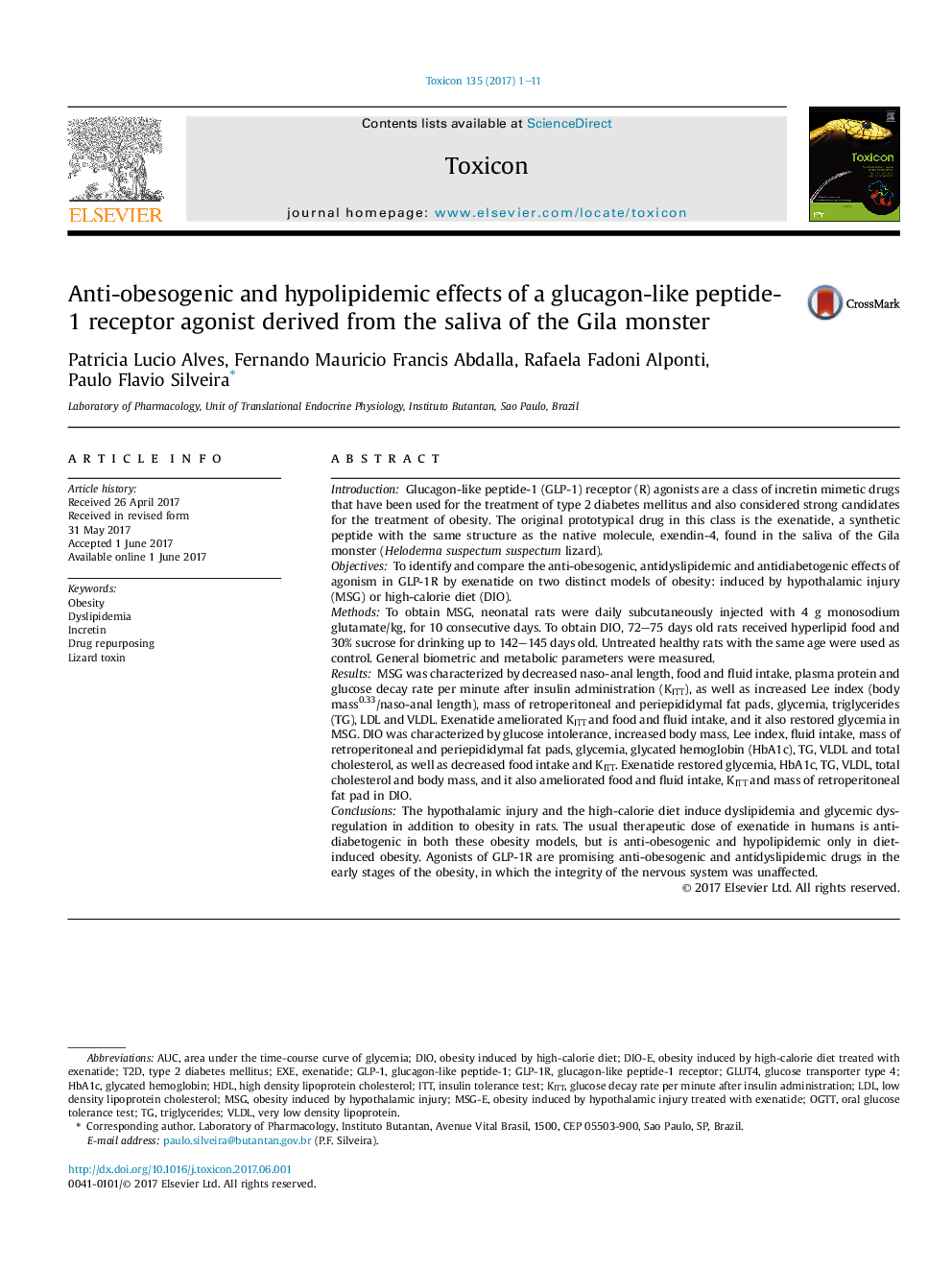| Article ID | Journal | Published Year | Pages | File Type |
|---|---|---|---|---|
| 5519335 | Toxicon | 2017 | 11 Pages |
â¢Central or diet-induced obesities promote dyslipidemia and glycemic dysregulation.â¢GLP-1R agonist exenatide (EXE) is antidiabetogenic in these obesity models.â¢EXE is anti-obesogenic and hypolipidemic only in diet-induced obesity.â¢Neuronal integrity is related to anti-obesogenic and lipid-lowering effects of EXE.â¢GLP-1R agonists are promising drugs in the early stages of obesity and dyslipidemia.
IntroductionGlucagon-like peptide-1 (GLP-1) receptor (R) agonists are a class of incretin mimetic drugs that have been used for the treatment of type 2 diabetes mellitus and also considered strong candidates for the treatment of obesity. The original prototypical drug in this class is the exenatide, a synthetic peptide with the same structure as the native molecule, exendin-4, found in the saliva of the Gila monster (Heloderma suspectum suspectum lizard).ObjectivesTo identify and compare the anti-obesogenic, antidyslipidemic and antidiabetogenic effects of agonism in GLP-1R by exenatide on two distinct models of obesity: induced by hypothalamic injury (MSG) or high-calorie diet (DIO).MethodsTo obtain MSG, neonatal rats were daily subcutaneously injected with 4Â g monosodium glutamate/kg, for 10 consecutive days. To obtain DIO, 72-75 days old rats received hyperlipid food and 30% sucrose for drinking up to 142-145 days old. Untreated healthy rats with the same age were used as control. General biometric and metabolic parameters were measured.ResultsMSG was characterized by decreased naso-anal length, food and fluid intake, plasma protein and glucose decay rate per minute after insulin administration (KITT), as well as increased Lee index (body mass0.33/naso-anal length), mass of retroperitoneal and periepididymal fat pads, glycemia, triglycerides (TG), LDL and VLDL. Exenatide ameliorated KITT and food and fluid intake, and it also restored glycemia in MSG. DIO was characterized by glucose intolerance, increased body mass, Lee index, fluid intake, mass of retroperitoneal and periepididymal fat pads, glycemia, glycated hemoglobin (HbA1c), TG, VLDL and total cholesterol, as well as decreased food intake and KITT. Exenatide restored glycemia, HbA1c, TG, VLDL, total cholesterol and body mass, and it also ameliorated food and fluid intake, KITT and mass of retroperitoneal fat pad in DIO.ConclusionsThe hypothalamic injury and the high-calorie diet induce dyslipidemia and glycemic dysregulation in addition to obesity in rats. The usual therapeutic dose of exenatide in humans is antidiabetogenic in both these obesity models, but is anti-obesogenic and hypolipidemic only in diet-induced obesity. Agonists of GLP-1R are promising anti-obesogenic and antidyslipidemic drugs in the early stages of the obesity, in which the integrity of the nervous system was unaffected.
